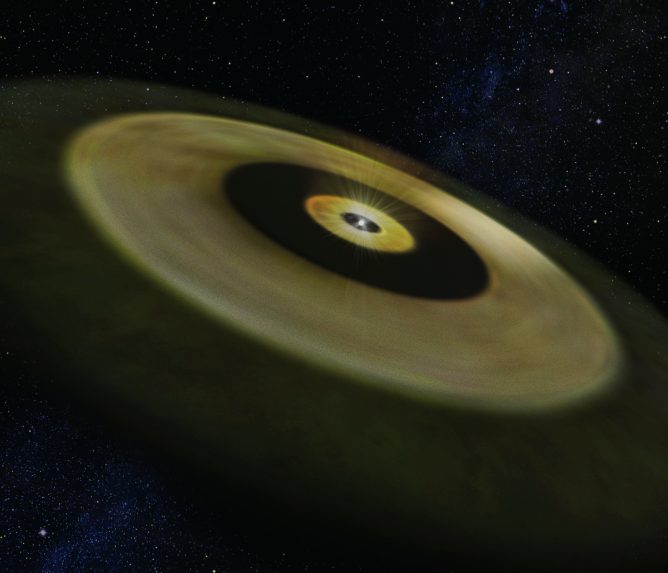Astronomers Peer at a Young Star System That Is Strikingly Similar to Our Own
Roughly 470 light years from Earth, in the constellation Taurus, there is a star system that looks uncannily similar to a younger version of our own solar neighborhood.
Not only does the system have a Sun-like star, called DM Tau, it has two dust rings that orbit at comparable distances to the asteroid belt and Neptune. All known planetary systems are built out of these dusty circles, which are called protoplanetary disks. Over millions of years, these huge clouds conglomerate into larger objects like asteroids and planets.
DM Tau is about three to five million years old, and half as massive as the Sun. The star is still building up its mass and will eventually mature into a main sequence star, meaning it will commence nuclear fusion of hydrogen.
The star has been studied for decades, but new details about the dusty disk surrounding it have now been detected by a team led by Tomoyuki Kudo, an astronomer at the National Astronomical Observatory of Japan.
Kudo and his colleagues observed the system with the Atacama Large Millimeter/submillimeter Array (ALMA), which is a collection of 66 radio telescopes in Chile that are especially attuned to observations of young stars and planets.
 ALMA image of the concentric rings where planets may be forming at DM Tau. Image: ALMA (ESO/NAOJ/NRAO), Kudo et al.
ALMA image of the concentric rings where planets may be forming at DM Tau. Image: ALMA (ESO/NAOJ/NRAO), Kudo et al. The goal was to test out two competing models of the star system: One suggested a dust ring orbited at a similar distance to the asteroid belt in our system, and another placed the ring farther out, around the distance between the Sun and Neptune.
"Our ALMA observations provided a clear answer: both are right," Kudo said in a statement. "DM Tau has two rings, one at each location."
The team's findings are published in The Astrophysical Journal, and were recently presented at the annual meeting of the Astronomical Society of Japan.
The ALMA observations revealed other clues that suggest DM Tau resembles the solar system during its infant years. For instance, the team pinpointed a bright spot nestled within the outer circle of dust that may be the embryo of a planet. If a new world does form there, it will occupy a comparable orbital distance to its star as Uranus and Neptune do in our solar system.
Perhaps the most tantalizing similarity, however, is that both the Sun and DM Tau are surrounded by a blank expanse that extends three to four astronomical units (AU) from the star (one AU is the distance between Earth and the Sun).
In our solar system, this gap is where Mercury, Venus, Earth, and Mars were born. That raises the possibility that terrestrial worlds might be forming around DM Tau, too.
Read More:We May Have Identified What Lies at the Outermost Edge of Our Solar System
Kudo and his colleagues note that there is substantial evidence that the asteroid belt was instrumental in making Earth habitable because impacts delivered water to our young planet. Given its location, the young asteroid belt at DM Tau could play the same role for any new worlds in the system's inner orbits.
"The inner ring is located at a strikingly similar distance to the main asteroid belt in the solar system between Mars and Jupiter," Kudo and his co-authors said in the paper. "Should terrestrial planets be forming inside its snowline, water delivery from the inner ring onto the inner planets might be plausible."
In another 4.5 billion years or so, maybe the DM Tau system will host life-forms that can gaze over to our solar neighborhood and watch the Sun expand into a red giant.
Get six of our favorite Motherboard stories every dayby signing up for our newsletter.